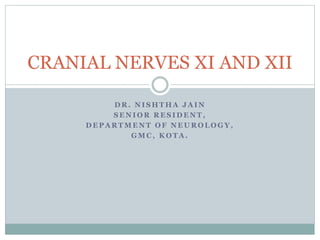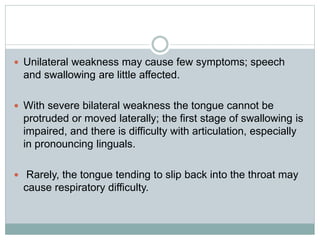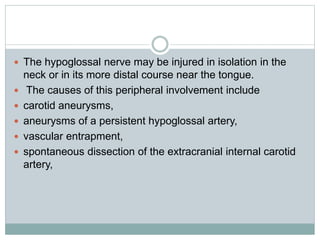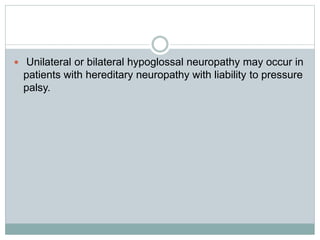Cranial nerves xi and xii
- 1. D R . N I S H T H A J A I N S E N I O R R E S I D E N T , D E P A R T M E N T O F N E U R O L O G Y , G M C , K O T A . CRANIAL NERVES XI AND XII
- 2. The Spinal Accessory Nerve The spinal accessory (SA) nerve - two nerves that run together in a common bundle for a short distance. The smaller cranial portion (ramus internus) is a special visceral efferent (SVE) accessory to the vagus. The cranial root runs to the jugular foramen and unites with the spinal portion, traveling with it for only a few millimeters to form the main trunk of CN XI.
- 3. The cranial root communicates with the jugular ganglion of the vagus, and then exits through the jugular foramen separately from the spinal portion. It passes through the ganglion nodosum and then blends with the vagus. Distributed principally with the recurrent laryngeal nerve to sixth branchial arch muscles in the larynx except there is no XI contribution to the cricothyroid muscle.
- 4. The major part of CN XI is the spinal portion (ramus externus). The fibers of the spinal root arise from SVE motor cells in the SA nuclei in the ventral horn from C2 to C5, or even C6. The supranuclear innervation of CN XI arises from the lower portion of the precentral gyrus.
- 5. The bulk of current evidence indicates that both the SCM and trapezius receive bilateral supranuclear innervation. The input to the SCM motor neuron pool - ipsilateral and that to the trapezius motor neuron pool - contralateral.
- 7. Somatotopic arrangement present : cord levels C1 and C2 innervate the ipsilateral sternocleidomastoid muscle, and levels C3 and C4 innervate primarily the ipsilateral trapezius. The corticobulbar fibers to the sternocleidomastoid are located in the brainstem tegmentum, whereas fibers to the trapezius are located in the ventral brainstem. Thus, a ventral pontine lesion can cause supranuclear paresis of the trapezius with sparing of the sternocleidomastoid muscle.
- 8. To assess SCM power, have the patient turn the head fully to one side and hold it there, then try to turn the head back to midline, avoiding any tilting or leaning motion. The muscle usually stands out well, and its contraction can be seen and felt. Significant weakness of rotation can be detected if the patient tries to counteract firm resistance.
- 9. The two sternocleidomastoid muscles can be examined simultaneously by having the patient flex his neck while the examiner exerts pressure on the forehead, or by having the patient turn the head from side to side. Flexion of the head against resistance may cause deviation of the head toward the paralyzed side.
- 10. With unilateral paralysis, the involved muscle is flat and does not contract or become tense when attempting to turn the head contralaterally or to flex the neck against resistance. Weakness of both SCMs causes difficulty in anteroflexion of the neck, and the head may assume an extended position.
- 13. With trapezius atrophy the outline of the neck changes, with depression or drooping of the shoulder contour and flattening of the trapezius ridge. The strength of the trapezius is traditionally tested by having the patient shrug the shoulders against resistance. To examine the middle and lower trapezius, place the patient's abducted arm horizontally, palm up, and attempt to push the elbow forward.
- 15. Weakness of the trapezius disrupts the normal scapulohumeral rhythm and impairs arm abduction. Impairment of upper trapezius function causes weakness of abduction beyond 90 degrees. Weakness of the middle trapezius muscle causes winging of the scapula. The winging due to trapezius weakness is more apparent on lateral abduction in contrast to the winging seen with serratus anterior weakness, which is greatest with the arm held in front.
- 16. When the trapezius is weak, the arm hangs lower on the affected side, and the fingertips touch the thigh at a lower level than on the normal side. Placing the palms together with the arms extended anteriorly and slightly below horizontal shows the fingers on the affected side extending beyond those of the normal side.
- 17. The two trapezius muscles can be examined simultaneously by having the patient extend his neck against resistance. Bilateral paralysis causes weakness of neck extension. The patient cannot raise his chin, and the head may tend to fall forward (dropped head syndrome). The shoulders look square or have a drooping, sagging appearance due to atrophy of both muscles.
- 18. Weakness of the muscles supplied by CN XI may be caused by supranuclear, nuclear, or infranuclear lesions. Supranuclear involvement usually causes at worst moderate loss of function since innervation is partially bilateral. In hemiplegia there is usually no head deviation, but testing may reveal slight, weakness of the SCM, with difficulty turning the face toward the involved limbs. There may be depression of the shoulder resulting from trapezius weakness on the affected side.
- 19. Irritative supranuclear lesions may cause head turning away from the discharging hemisphere. This turning of the head (or head and eyes) may occur as part of a contraversive, ipsiversive, or jacksonian seizure, and is often the first manifestation of the seizure. Extrapyramidal lesions may also involve the sternocleidomastoid and trapezius muscles, causing rigidity, akinesis, or hyperkinesis.
- 20. Lesions of the lower brainstem or upper cervical spinal cord may cause dissociated weakness of the SCM and trapezius muscles depending on the exact location. Nuclear involvement of the SA nerve may occur in motor neuron disease, syringobulbia, and syringomyelia. In nuclear lesions, the weakness is frequently accompanied by atrophy and fasciculations.
- 21. Localisation Weakness of the trapezius on one side associated with weakness of the sternocleidomastoid on the other side (dissociated weakness) indicates an upper motor neuron lesion ipsilateral to the weak sternocleidomastoid. Weakness of the trapezius on one side with sparing of the sternocleidomastoid muscles indicates a ventral brainstem lesion, a lower cervical cord lesion, or a lower spinal accessory root lesion.
- 22. Weakness of the sternocleidomastoid with trapezius sparing indicates a lesion of the lower brainstem tegmentum or upper cervical accessory roots. Weakness of the sternocleidomastoid and the trapezius muscles on the same side indicates a contralateral brainstem lesion, an ipsilateral high cervical cord lesion, or an accessory nerve lesion before the nerve divides into its sternocleidomastoid and trapezius branches.
- 23. The Hypoglossal Nerve The hypoglossal nerve (CN XII) - a pure motor nerve, supply the tongue. The branches of the hypoglossal nerve are the meningeal, descending, thyrohyoid, and muscular. The meningeal branches send filaments derived from communicating branches with C1 and C2 to the dura of the posterior fossa.
- 24. The descending ramus sends a branch to the omohyoid, and then joins a descending communicating branch from C2 and C3 to form the ansa hypoglossi which supplies the omohyoid, sternohyoid, and sternothyroid muscles. The thyrohyoid branch supplies the thyrohyoid muscle. The descending and thyrohyoid branches carry hypoglossal fibers but are derived mainly from the cervical plexus.
- 25. CN XII supplies the intrinsic muscles, all of the extrinsic muscles of the tongue except the palatoglossus, and possibly the geniohyoid muscle. The cerebral center regulating tongue movements lies in the lower portion of the precentral gyrus near and within the sylvian fissure. Supranuclear control to the genioglossus muscle is primarily crossed; supply to the other muscles is bilateral but predominantly crossed.
- 27. The clinical examination of hypoglossal nerve function consists of evaluating the strength, bulk, and dexterity of the tongue—looking especially for weakness, atrophy, abnormal movements (particularly fasciculations), and impairment of rapid movements. After noting the position and appearance of the tongue at rest in the mouth, the patient is asked to protrude it, move it in and out, from side to side, and upward and downward, both slowly and rapidly.
- 28. Motor power can be tested by having the patient press the tip against each cheek as the examiner tries to dislodge it with finger pressure. The normal tongue is powerful and cannot be moved. When unilateral weakness is present, the tongue deviates toward the weak side on protrusion because of the action of the normal genioglossus.
- 29. The patient cannot push the tongue against the cheek on the normal side, but is able to push it against the cheek on the side toward which it deviates.
- 31. Unilateral weakness may cause few symptoms; speech and swallowing are little affected. With severe bilateral weakness the tongue cannot be protruded or moved laterally; the first stage of swallowing is impaired, and there is difficulty with articulation, especially in pronouncing linguals. Rarely, the tongue tending to slip back into the throat may cause respiratory difficulty.
- 32. Supranuclear Lesions Lesions of the corticobulbar tract anywhere in its course from the lower precentral gyrus to the hypoglossal nuclei may result in tongue paralysis. A lesion of the corticobulbar fibers above their decussation result in weakness of the contralateral half of the tongue. A supranuclear lesion is not accompanied by atrophy or fibrillations of the tongue.
- 33. Sudden isolated dysarthria may occur with lacunar infarcts affecting the contralateral corona radiata or internal capsule, which interrupt in isolation the cortico-lingual pathways to the tongue (central monoparesis of the tongue). The main decussation of supranuclear projections to the hypoglossal nucleus in the brainstem is located close to the pontomedullary junction.
- 34. Pontine lesions at the ventral paramedian base close to the midline affect the contralateral cortico-hypoglossal projections, whereas lateral lesions at the pontine base affect ipsilateral projections.
- 35. Nuclear Lesions and Intramedullary Cranial Nerve XII Lesions Unilateral lesions of the hypoglossal nucleus or nerve result in paresis, atrophy, furrowing, fibrillations, and fasciculations that affect the corresponding half of the tongue. Because of the close proximity of the two hypoglossal nuclei, dorsal medullary lesions (e.g., multiple sclerosis, syringobulbia) often result in bilateral lower motor neuron lesions of the tongue.
- 36. A rare but characteristic syndrome that affects the hypoglossal nerve in its intramedullary course is the medial medullary syndrome (Dejerine's anterior bulbar syndrome). This syndrome results from occlusion of the anterior spinal artery or its parent vertebral artery.
- 37. The anterior spinal artery supplies the ipsilateral pyramid, medial lemniscus, and hypoglossal nerve; its occlusion therefore results in three main signs: Ipsilateral paresis, atrophy, and fibrillations of the tongue (due to affection of cranial nerve XII). Contralateral hemiplegia (due to involvement of the pyramid) with sparing of the face. Contralateral loss of position and vibratory sensation (due to involvement of the medial lemniscus).
- 38. Peripheral Lesions of Cranial Nerve XII With neck lesions, the cervical sympathetic chain may be involved, resulting in an ipsilateral Horner syndrome (miosis, anhidrosis, and ptosis). Isolated hypoglossal nerve palsy has been described due to compression by a kinked vertebral artery (hypoglossal- vertebral entrapment syndrome). Skull metastases to the clivus may cause bilateral hypoglossal nerve palsies.
- 39. Combined abducens nerve and hypoglossal nerve palsies are rare. This ominous combination may be seen with nasopharyngeal carcinoma (Godtfredsen's syndrome) and with other clival lesions, especially tumors (three-fourths of which are malignant). Lesions, usually tumors or chronic inflammatory lesions, of the occipital condyle may cause occipital pain associated with an ipsilateral hypoglossal nerve injury (occipital condyle syndrome).
- 40. The hypoglossal nerve may be injured in isolation in the neck or in its more distal course near the tongue. The causes of this peripheral involvement include carotid aneurysms, aneurysms of a persistent hypoglossal artery, vascular entrapment, spontaneous dissection of the extracranial internal carotid artery,
- 41. local infections, tuberculosis of the atlantoaxial joint, rheumatoid arthritis, surgical (e.g., carotid endarterectomy) or accidental trauma, birth injuries, neck radiation, and tumors of the retroparotid or retropharyngeal spaces, neck, salivary glands, and base of the tongue.
- 42. Unilateral or bilateral hypoglossal neuropathy may occur in patients with hereditary neuropathy with liability to pressure palsy.
- 43. Referrences Dejong’s the neurologic examination, 6th edition. Localisation in clinical neurology, 5th edition. Bradley’s neurology, 6th edition.










































